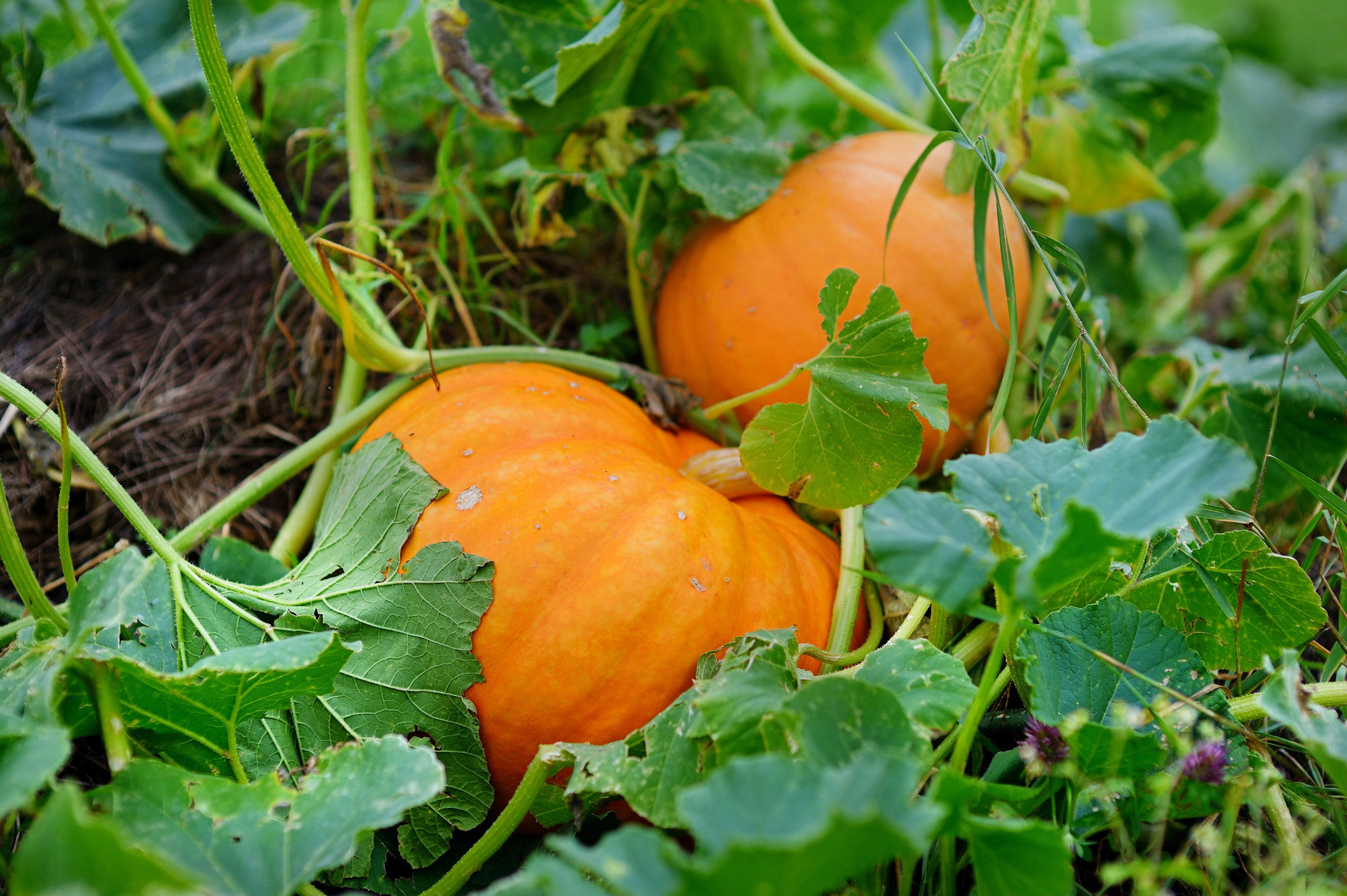Pumpkin Donation Tracker
Quick Links: How & Where to Grow | Temperature | How to Care For | Harvest Signs | Harvesting | Pruning | Storage | Pests | Varieties | Preservation | Recipes | Michigan Tips | Fun Facts
🌱 How & Where to Grow Pumpkins:
- Plant early June for Halloween – timing is everything for pumpkins!
- Direct sow when soil reaches 65°F.
- Space plants 4-6 feet apart for small varieties, 8-10 feet for large.
- Sunlight: Full sun (8+ hours) for best development.
- Soil Type: Rich, well-drained soil with pH 6.0-6.8.
- Soil Amendment: Work in generous compost – pumpkins are heavy feeders
Count backwards from Halloween – most pumpkins need 90-120 days to mature!
🌡️ Temperature Guidance:
Very cold-sensitive. Use black plastic, raised beds.
- Planting: Minimum 65°F soil, 70°F is better.
- Growing: Thrives at 65-85°F air temperature.
- Frost kills vines instantly – protect young plants.
- Cool nights slow growth and ripening.
Michigan’s variable spring means row covers are insurance for early plantings!
💧 How to Care for:
- Consistent Moisture: Critical during fruit development.
- Watering: Deep weekly watering – 1 inch minimum.
- Mulch: Heavy straw mulch keeps fruit clean and soil moist.
- Fertilizer: Feed every 2 weeks once vines start running.
- Fruit support: Place boards under developing pumpkins to prevent rot.
📏 Harvest Signs:
Deep color, hard rind, hollow thump, dry stem.
- A ripe pumpkin sounds like a drum when thumped!
- Full color development for variety – orange, white, etc.
- Stem begins to dry and turn brown.
- Rind resists fingernail pressure.
- Vines naturally dying back.
Harvest before hard freeze but after full color development!
🧺 Harvesting:
Cut with 3-4 inch stem. Never carry by stem. Harvest before hard freeze.
- Always use sharp knife or pruners to cut stem.
- Leave 3-4 inches of stem – crucial for storage.
- Support pumpkin’s weight from bottom when moving.
- Handle carefully – damaged skin leads to rot.
- Wipe clean but don’t wash until use.
✂️ Pruning:
Limit pumpkins per vine. Pinch tips. Remove late flowers.
- For giant pumpkins: Allow only 1 per vine.
- For standard size: Keep 2-4 pumpkins per vine.
- Pinch vine tips when pumpkins reach softball size.
- Remove all flowers after August 1 – won’t mature.
- Bury vines at leaf nodes to prevent vine borer damage.
📦 Storage:
Cure 10 days at 80-85°F. Store 50-55°F for 2-5 months.
- Field cure if weather permits – leave in sun 7-10 days.
- Indoor curing at 80-85°F heals stem wounds.
- Long-term storage at 50-55°F with 50-70% humidity.
- Handle by body, never by stem.
- Wipe with dilute bleach solution to prevent rot.
- Check regularly – remove any showing soft spots.
🪲 Michigan Pests:
Vine borers peak July. Squash bugs numerous. Cucumber beetles.
- Squash vine borers – worst in July. Time planting to avoid peak.
- Squash bugs – check for eggs daily, destroy immediately.
- Cucumber beetles – spread bacterial wilt, devastating to vines.
- Powdery mildew – affects leaves late season.
🎃 Varieties:
Carving: ‘Connecticut Field’. Pie: ‘Sugar Pie’. Mini: ‘Jack-Be-Little’.
- ‘Connecticut Field’: 120 days, classic jack-o’-lantern type.
- ‘Sugar Pie’: 100 days, best for eating and baking.
- ‘Jack-Be-Little’: 90 days, decorative mini pumpkins.
- ‘Howden’: 115 days, perfect carving pumpkin.
- ‘Jarrahdale’: 100 days, blue-gray heirloom, excellent eating.
🫙 Preservation:
Fresh storage. Pressure can cubed only. Freeze puree.
- Fresh storage: Whole pumpkins keep 2-5 months properly stored.
- Puree: Roast, scoop, puree, and freeze in recipe portions.
- Pressure canning: Only safe method – never water bath can.
- Dehydrate: Slice thin for chips or powder.
- Seeds: Roast with salt for healthy snacks.
- Not recommended: Canning pumpkin butter (too dense).
🧑🏽🍳 Recipes:
Pumpkin pie, soup, roasted seeds, pumpkin butter.
- Classic pumpkin pie – use ‘Sugar Pie’ variety.
- Creamy pumpkin soup with nutmeg and cream.
- Pumpkin bread – like banana bread but fall-themed!
- Savory stuffed pumpkin with rice and sausage.
- Pumpkin smoothies for breakfast nutrition.
✋🏼 Michigan Tips:
- June 1-15 planting for October harvest.
- Use row covers for early growth boost.
- Plant mini varieties if space is limited.
- Succession plant 2 weeks apart for extended harvest.
- Michigan’s humidity increases disease – space well.
- Consider bush varieties to reduce vine borer damage.
🧠 Fun Facts:
- 90% water.
- Illinois grows 85% processing pumpkins.
- World record 2,700+ pounds!
- Pumpkins are native to North America – grown for 9,000 years!
- Every part is edible – flesh, seeds, flowers, even leaves.
- Pumpkin pie spice contains no pumpkin – just cinnamon, nutmeg, ginger, cloves.
- The tradition of carving pumpkins came from Ireland (they used turnips!).
- Michigan ranks in top 10 states for pumpkin production!


0 Comments